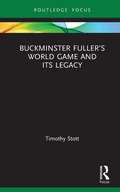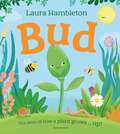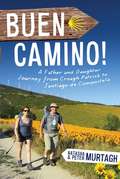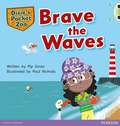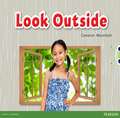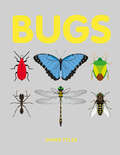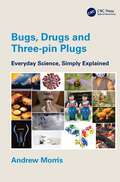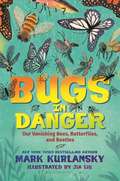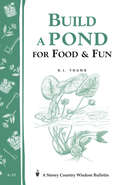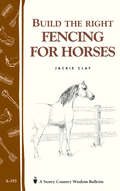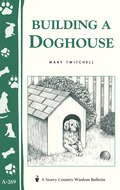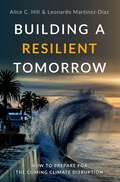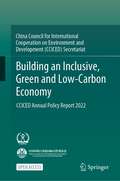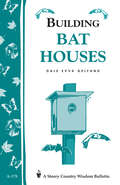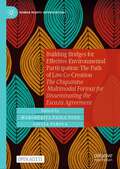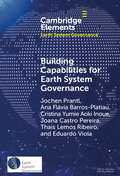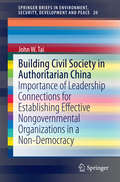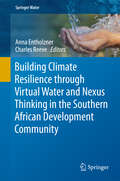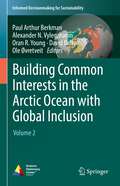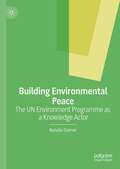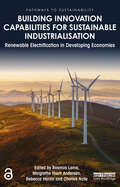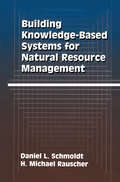- Table View
- List View
Buckminster Fuller’s World Game and Its Legacy (Routledge Focus on Art History and Visual Studies)
by Timothy StottThis book studies R. Buckminster Fuller’s World Game and similar world games, past and present. Proposed by Fuller in 1964 and first played in colleges and universities across North America at a time of growing ecological crisis, the World Game attempted to turn data analysis, systems modelling, scenario building, computer technology, and information design to more egalitarian ends to meet human needs. It challenged players to redistribute finite planetary resources more equitably, to ‘make the world work’. Criticised and lauded in equal measure, the World Game has evolved through several formats and continues today in correspondence with debates on planetary stewardship, gamification, data management, and the democratic deficit. This book looks again at how the World Game has been played, focusing on its architecture, design, and gameplay. With hindsight, the World Game might appear naïve, utopian, or technocratic, but we share its problems, if not necessarily its solutions. Such a study will be of interest to scholars working in art history, design history, game studies, media studies, architecture, and the environmental humanities.
Bud: The story of how a plant grows ... up!
by Laura HambletonThis bright, fun and friendly non-fiction picture book about what happens when one plant grows (up) is a gentle introduction to plant life cycles for readers 3+.Meet Bud, a TINY rosebud on a BIG adventure. Sitting in a cosy greenhouse, in an even cosier red pot is Bud. Every day, Bud is warmed by Sun and told stories about the BIg Outside by Moon. Bud is happy and content until ... POP! Bud is planted beside looming trees and wiggly worms. The Big Outside is SCARY - but new adventures can be, and there's no bigger adventure than growing up. A reassuring growing-up story with facts about plants, this adorable book will inspire green fingers in little ones while preparing them for their own growing-up journey.
Buen Camino! Walk the Camino de Santiago with a Father and Daughter: A Physical Journey that Became a Spiritual Transformation
by Peter Murtagh Natasha MurtaghHave you ever dreamed about walking the Camino de Santiago? Join Peter Murtagh, acclaimed Irish journalist, and his teenage daughter Natasha on their epic pilgrimage across the Way of St James and experience their life-changing adventure with them.If you’ve ever wondered what a hike of 900 miles involves, physically and emotionally, look no further than Buen Camino! You will be transported to Northern Spain, to bull-running and fiestas, to prayers and ancient Christian churches, to a gruelling trek that leads to a spiritual transformation. You’ll meet a motley crew of Camino pilgrims, stay with Peter and Natasha in Spartan hostels, learn about the history of the Camino and, above all, laugh and cry with a loving father and daughter as they walk steps trod by thousands of religious travellers before them.Whether you’re a seasoned ‘peregrino’ seeking to relive your glorious Camino days, a Camino novice looking for stories of Camino veterans or someone who’s never even heard of the Camino, Buen Camino! is a must-read, full of drama, exhilaration, love, laughter and spiritual and emotional revelations.More than just a travelogue, Buen Camino! is the unique story of the shared emotional journey of a loving Irish father and daughter and of the deep family bond their shared journey of self-discovery forges. Be seduced by the spirit of the Camino and join Peter and Natasha as they follow the ancient route of Irish monks on pilgrimage and find a way of living in the world more simply.Light in weight, and available as an ebook, this is the perfect Camino companion. ‘A lovely book for those who have done the Camino, or like me, are thinking of doing it’The Dubliner‘An addictive, funny, heart-warming, informative read’ The Irish Mail
Bug Club Green A Dixie's Pocket Zoo: Brave The Waves (PDF)
by Pip JonesWhen Dixie spots a sinking boat, she turns to her magic pocket zoo for help. Can the animals save the day and bring everyone to safety?
Bugs
by Simon TylerPacked with stunning, detailed illustrations and astonishing facts, this book will introduce you to some of the strangest, scariest, biggest, smallest and most beautiful insects around.
Bugs, Drugs and Three-pin Plugs: Everyday Science, Simply Explained
by Andrew MorrisFor the millions who remain curious about the world around them, but gained little from science at school, this book offers a way forward. Based on live discussions with adults from all walks of life, each chapter begins with an everyday experience, like swallowing a pill or watching a bee on a flower. The main scientific ideas underlying each topic are then explored, so that understanding of a set of fundamental concepts builds up gradually throughout the book. In contrast to more traditional approaches to science learning, topics range freely across the subject areas. The story of Covid, for example includes aspects of biology, chemistry, mathematics and social behaviour. Plain English is used throughout and mathematical expressions are avoided. Key points are illustrated with clear diagrams and photographs. By drawing on questions and perspectives of ordinary people, the book offers an introduction to basic ideas in science as a whole, rather than any one particular subject. For the adult wishing to make good a gap in their understanding it provides a starting point for entering the rich world of popular science.
Bugs, Drugs and Three-pin Plugs: Everyday Science, Simply Explained
by Andrew MorrisFor the millions who remain curious about the world around them, but gained little from science at school, this book offers a way forward. Based on live discussions with adults from all walks of life, each chapter begins with an everyday experience, like swallowing a pill or watching a bee on a flower. The main scientific ideas underlying each topic are then explored, so that understanding of a set of fundamental concepts builds up gradually throughout the book. In contrast to more traditional approaches to science learning, topics range freely across the subject areas. The story of Covid, for example includes aspects of biology, chemistry, mathematics and social behaviour. Plain English is used throughout and mathematical expressions are avoided. Key points are illustrated with clear diagrams and photographs. By drawing on questions and perspectives of ordinary people, the book offers an introduction to basic ideas in science as a whole, rather than any one particular subject. For the adult wishing to make good a gap in their understanding it provides a starting point for entering the rich world of popular science.
Bugs in Danger: Our Vanishing Bees, Butterflies, and Beetles
by Mark KurlanskyBy now you've probably heard that bees are disappearing--but they aren't the only species at risk. Populations of fireflies, butterflies, and ladybugs have all been declining in recent years, too. This middle grade nonfiction explains the growth, spread, and recent declines of each of these four types of insects. Exploring human causes, like the Baltimore electric company that collected fireflies to attempt to harness their phosphorescent lighting source, to natural occurrences, like the mysterious colony collapse disorder that plagues bee populations, master nonfiction storyteller Mark Kurlansky shows just how much bugs matter to our world.
Build a Pond for Food & Fun: Storey's Country Wisdom Bulletin A-19 (Storey Country Wisdom Bulletin)
by D. J. YoungSince 1973, Storey's Country Wisdom Bulletins have offered practical, hands-on instructions designed to help readers master dozens of country living skills quickly and easily. There are now more than 170 titles in this series, and their remarkable popularity reflects the common desire of country and city dwellers alike to cultivate personal independence in everyday life.
Build the Right Fencing for Horses: Storey's Country Wisdom Bulletin A-193 (Storey Country Wisdom Bulletin)
by Jackie ClaySince 1973, Storey's Country Wisdom Bulletins have offered practical, hands-on instructions designed to help readers master dozens of country living skills quickly and easily. There are now more than 170 titles in this series, and their remarkable popularity reflects the common desire of country and city dwellers alike to cultivate personal independence in everyday life.
Building a Doghouse: (Storey's Country Wisdom Bulletins A-269) (Storey Country Wisdom Bulletin)
by Mary TwitchellBuild a Doghouse That's Just Right for Your Dog!While your dog may be a full-fledged member of the family, there are times when you must put him or her outdoors. Some dogs, for example, become over enthusiastically friendly when visitors appear, even to the point of knocking down your unsuspecting guests. Other dogs enjoy having some time to themselves in the backyard. Whatever the reason that shepherds the dog out the door, a nearby doghouse within a fenced-in area provides a protected, private space for your dog and peace of mind for you. A proper doghouse is a canine retreat, a place where your dog can hide from the hot sun, the cold rain, the harsh wind, and the worries of the world. Mary Twitchell takes you through all the options for building or buying a comfortable and cozy shelter for your canine companion. Whether you want to modify a barrel, buy a molded plastic shelter, or build a wooden doghouse, you'll find all the information you need right here, from choosing the right site to proper building techniques to encouraging your dog to use the new doghouse.
Building a Resilient Tomorrow: How to Prepare for the Coming Climate Disruption
by Alice C. Hill Leonardo Martinez-DiazClimate change impacts-more heat, drought, extreme rainfall, and stronger storms-have already harmed communities around the globe. Even if the world could cut its carbon emissions to zero tomorrow, further significant global climate change is now inevitable. Although we cannot tell with certainty how much average global temperatures will rise, we do know that the warming we have experienced to date has caused significant losses, and that the failure to prepare for the consequences of further warming may prove to be staggering. Building a Resilient Tomorrow does not dwell on overhyped descriptions of apocalyptic climate scenarios, nor does it travel down well-trodden paths surrounding the politics of reducing carbon emissions. Instead, it starts with two central facts: climate impacts will continue to occur, and we can make changes now to mitigate their effects. While squarely confronting the scale of the risks we face, this pragmatic guide focuses on solutions-some gradual and some more revolutionary-currently being deployed around the globe. Each chapter presents a thematic lesson for decision-makers and engaged citizens to consider, outlining replicable successes and identifying provocative recommendations to strengthen climate resilience. Between animated discussions of ideas as wide-ranging as managed retreat from coastal hot-zones to biological approaches for resurgent climate-related disease threats, Alice Hill and Leonardo Martinez-Diaz draw on their personal experiences as senior officials in the Obama Administration to tell behind-the-scenes stories of what it really takes to advance progress on these issues. The narrative is dotted with tales of on-the-ground citizenry, from small-town mayors and bankers to generals and engineers, who are chipping away at financial disincentives and bureaucratic hurdles to prepare for life on a warmer planet. For readers exhausted by today's paralyzing debates on yearly "fluke" storms or the existence of climate change, Building a Resilient Tomorrow offers better ways to manage the risks in a warming planet, even as we work to limit global temperature rise.
Building a Resilient Tomorrow: How to Prepare for the Coming Climate Disruption
by Leonardo Martinez-Diaz Alice C. HillClimate change impacts-more heat, drought, extreme rainfall, and stronger storms-have already harmed communities around the globe. Even if the world could cut its carbon emissions to zero tomorrow, further significant global climate change is now inevitable. Although we cannot tell with certainty how much average global temperatures will rise, we do know that the warming we have experienced to date has caused significant losses, and that the failure to prepare for the consequences of further warming may prove to be staggering. Building a Resilient Tomorrow does not dwell on overhyped descriptions of apocalyptic climate scenarios, nor does it travel down well-trodden paths surrounding the politics of reducing carbon emissions. Instead, it starts with two central facts: climate impacts will continue to occur, and we can make changes now to mitigate their effects. While squarely confronting the scale of the risks we face, this pragmatic guide focuses on solutions-some gradual and some more revolutionary-currently being deployed around the globe. Each chapter presents a thematic lesson for decision-makers and engaged citizens to consider, outlining replicable successes and identifying provocative recommendations to strengthen climate resilience. Between animated discussions of ideas as wide-ranging as managed retreat from coastal hot-zones to biological approaches for resurgent climate-related disease threats, Alice Hill and Leonardo Martinez-Diaz draw on their personal experiences as senior officials in the Obama Administration to tell behind-the-scenes stories of what it really takes to advance progress on these issues. The narrative is dotted with tales of on-the-ground citizenry, from small-town mayors and bankers to generals and engineers, who are chipping away at financial disincentives and bureaucratic hurdles to prepare for life on a warmer planet. For readers exhausted by today's paralyzing debates on yearly "fluke" storms or the existence of climate change, Building a Resilient Tomorrow offers better ways to manage the risks in a warming planet, even as we work to limit global temperature rise.
Building an Inclusive, Green and Low-Carbon Economy: CCICED Annual Policy Report 2022
by CCICEDThis open access book introduces the major environmental green development issues from six major themes carbon neutrality, nature-based solution, watershed management and climate adaptation, BRI green development, sustainable food supply chain, ecosystem-based integrated ocean management focusing on the progress of China’s environment and development policies from 2021 accomplishments. It is based on the research outputs of CCICED in the year of 2021, which marks China’s start point of implementation of its 14th Five-Year Plan when world economy also strived to recover from the pandemic.
Building Bat Houses: Storey's Country Wisdom Bulletin A-178 (Storey Country Wisdom Bulletin)
by Dale Evva GelfandSince 1973, Storey's Country Wisdom Bulletins have offered practical, hands-on instructions designed to help readers master dozens of country living skills quickly and easily. There are now more than 170 titles in this series, and their remarkable popularity reflects the common desire of country and city dwellers alike to cultivate personal independence in everyday life.
Building Bridges for Effective Environmental Participation: The Chiquitano Multimodal Format for Disseminating the Escazú Agreement (Human Rights Interventions)
by Margherita Paola Poto Giulia ParolaThis open-access book aims to explore and promote indigenous participation in legal design and visual law, with a specific focus on co-creating a visual representation of the Escazu Agreement in collaboration with the Chiquitano people. This project stands out as a unique and transformative endeavor, offering distinctive features and a range of benefits to its readers and stakeholders.
Building Capabilities for Earth System Governance (Elements in Earth System Governance)
by null Jochen Prantl null Ana Flávia Barros-Platiau null Cristina Yumie Inoue null Joana Castro Pereira null Thais Lemos Ribeiro null Eduardo ViolaThis Element develops a new Strategic Capabilities Framework for studying and steering complex socio-ecological systems. It is driven by the central question of what are the most essential capabilities that ought to be fostered for addressing the fundamental 21st Century environmental challenges and Earth system transformations. The author's objective is to innovate transformative ideas toward better climate and ocean governance that are of interest both to academics and policymakers in the field. Rather than investigating the design and effectiveness of institutions in governing the climate and the oceans, the authors offer an alternative approach starting from the assumption that global governance arrangements must be informed by the capabilities of the communities affected. This Element aims to offer out-of-the-box thinking about capabilities-focused and community-centered frameworks that align multi-level systems of governance with the fundamental challenges of global environmental change. This title is also available as Open Access on Cambridge Core.
Building Civil Society in Authoritarian China: Importance of Leadership Connections for Establishing Effective Nongovernmental Organizations in a Non-Democracy (SpringerBriefs in Environment, Security, Development and Peace #20)
by John W. TaiHow is modern civil society created? There are few contemporary studies on this important question and when it is addressed, scholars tend to emphasize the institutional environment that facilitates a modern civil society. However, there is a need for a new perspective on this issue. Contemporary China, where a modern civil society remains in a nascent stage, offers a valuable site to seek new answers. Through a comparative analysis of nongovernmental organizations (NGOs) in today’s China, this study shows the importance of the human factor, notably the NGO leadership, in the establishment of a modern civil society. In particular, in recognition of the social nature of NGOs, this study engages in a comparative examination of Chinese NGO leaders’ state linkage, media connections and international ties in order to better understand how each factor contributes to effective NGOs.
Building Climate Resilience through Virtual Water and Nexus Thinking in the Southern African Development Community (Springer Water)
by Anna Entholzner Charles ReeveThis book puts the spotlight on Southern Africa, presenting a cutting-edge concept never previously explored in the context of climate change and putting forward arguments for regional integration and cooperation. The Climate Resilient Infrastructure Development Facility (CRIDF) is the new water infrastructure program of the UK Department for International Development (DFID) for Southern Africa. The CRIDF promotes the establishment of small to medium-scale infrastructure across the Southern African Development Community (SADC) through technical assistance aimed at developing sustainable pro-poor projects, while also facilitating access to the financial resources needed to deliver said infrastructure. Further, it focuses on regional water resource management goals and basin plans, as well as on building climate resilience for the beneficiary communities. The Facility’s Virtual Water and Nexus Project works to improve regional peace dividends by translating the Nexus concept into national and regional policies; it ultimately promotes sovereign security through greater regional integration across the water, food and energy sectors, while taking into account potential benefits in connection with carbon sequestration and emission mitigation.
Building Common Interests in the Arctic Ocean with Global Inclusion: Volume 2 (Informed Decisionmaking for Sustainability)
by Oran R. Young Paul Arthur Berkman Alexander N. Vylegzhanin David A. Balton Ole Rasmus ØvretveitThis book contains an inclusive compilation of perspectives about the Arctic Ocean with contributions that extend from Indigenous residents and early career scientists to Foreign Ministers, involving perspectives across the spectrum of subnational-national-international jurisdictions. The Arctic Ocean is being transformed with global climate warming into a seasonally ice-free sea, creating challenges as well as opportunities that operate short-to-long term, underscoring the necessity to make informed decisions across a continuum of urgencies from security to sustainability time scales. The Arctic Ocean offers a case study with lessons that are especially profound at this moment when humankind is exposed to a pandemic, awakening a common interest in survival across our globally-interconnected civilization unlike any period since the Second World War. This second volume in the Informed Decisionmaking for Sustainability series reveals that building global inclusion involves common interests to address changes effectively “for the benefit of all on Earth across generations.”
Building Environmental Peace: The UN Environment Programme as a Knowledge Actor
by Natalia DalmerBy analyzing the UN Environment Programme’s (UNEP’s) contribution to peacebuilding, this book aims to show how international bureaucracies develop knowledge and thereby come to matter on the world stage. Portraying UNEP as an open system, it explores how a growing understanding within the Programme of how environmental degradation shapes insecurities and vice versa has motivated its work on peacebuilding. The theoretical part of this book addresses knowledge, open systems, and knowledge creation. It then presents a historical discussion of UNEP’s development in an open system context. Finally, it investigates how knowledge emergence on the linkage between the environment, conflicts, and insecurities influenced UNEP’s interests and its work on environmental peacebuilding.
Building Innovation Capabilities for Sustainable Industrialisation: Renewable Electrification in Developing Economies (Pathways to Sustainability)
by Rasmus Lema Margrethe Holm Andersen Rebecca Hanlin Charles NzilaThis book argues that renewable electrification in developing countries provides important opportunities for local economic development, but new pathways are required for turning these opportunities into successful reality. Building Innovation Capabilities for Sustainable Industrialisation offers a novel input into the debate on development of capabilities for sustainable industrialisation and delivers key insights for both researchers and policy makers when it comes to the question of how to increase the economic co-benefits of renewables expansion. The chapters in the book use a tailored analytical framework in their studies of renewable electrification efforts in Kenya and other countries in sub-Saharan Africa. They draw on a mix of project, sector and country level case studies to address questions such as: What capabilities are developed through on-going renewable electrification projects in developing economies? How can the expansion of renewable electrification be supported in a way that also encourages sustainable economic development? What role do international linkages (South-South and North-South) play and what role should they play in the greening of energy systems in developing economies? The authors provide a new understanding of how green transformation and sustainable industrialisation can be combined, highlighting the opportunities and constraints for local capability building and the scope for local policy action. This book will be of great interest to students and scholars of development studies, energy studies, sustainability and sustainable development, as well as practitioners and policy makers working in development organisations and national governments.
Building Innovation Capabilities for Sustainable Industrialisation: Renewable Electrification in Developing Economies (Pathways to Sustainability)
by Rasmus Lema, Margrethe Holm Andersen, Rebecca Hanlin and Charles NzilaThis book argues that renewable electrification in developing countries provides important opportunities for local economic development, but new pathways are required for turning these opportunities into successful reality. Building Innovation Capabilities for Sustainable Industrialisation offers a novel input into the debate on development of capabilities for sustainable industrialisation and delivers key insights for both researchers and policy makers when it comes to the question of how to increase the economic co-benefits of renewables expansion. The chapters in the book use a tailored analytical framework in their studies of renewable electrification efforts in Kenya and other countries in sub-Saharan Africa. They draw on a mix of project, sector and country level case studies to address questions such as: What capabilities are developed through on-going renewable electrification projects in developing economies? How can the expansion of renewable electrification be supported in a way that also encourages sustainable economic development? What role do international linkages (South-South and North-South) play and what role should they play in the greening of energy systems in developing economies? The authors provide a new understanding of how green transformation and sustainable industrialisation can be combined, highlighting the opportunities and constraints for local capability building and the scope for local policy action. This book will be of great interest to students and scholars of development studies, energy studies, sustainability and sustainable development, as well as practitioners and policy makers working in development organisations and national governments.
Building Knowledge-Based Systems for Natural Resource Management
by Daniel L. Schmoldt H. Michael RauscherIf one were forced to use a single key word to describe the decade of the 1980's, a very prominent one would be "technology. " Leading the forefront of tech nology advancement were breakthroughs in electronics. Devices that were uncommon or unknown in 1980 became commonplace, and almost indispens able, by 1989. This trend has continued into the 1990's and it does not seem to be abating in any way. Microwave ovens, video recorders, telephone answer ing machines, compact disc players, computers, and a host of smaller or less sophisticated devices now appear in most households. The development of small and inexpensive computers, i. e. , personal computers, has placed computing resources within reach of many more people. In addition, many traditional, and largely mechanical devices, have been enhanced by electronics. For example, specialized microprocessors are combined with arrays of electronic sensors to control and monitor sophisticated engineering components in most new auto mobiles. In this and many other ways, we are touched by the new electronics in almost every aspect of our daily lives. Initially, personal computers were little more than toys. They contained only a small fraction of the computing power of their immediate ancestors, the mini computers and mainframe computers. However, rapid improvements in integ rated circuit design and chip manufacture produced regular reductions in size and cost of computer components. During the same time, processor speed and sophistication increased.
